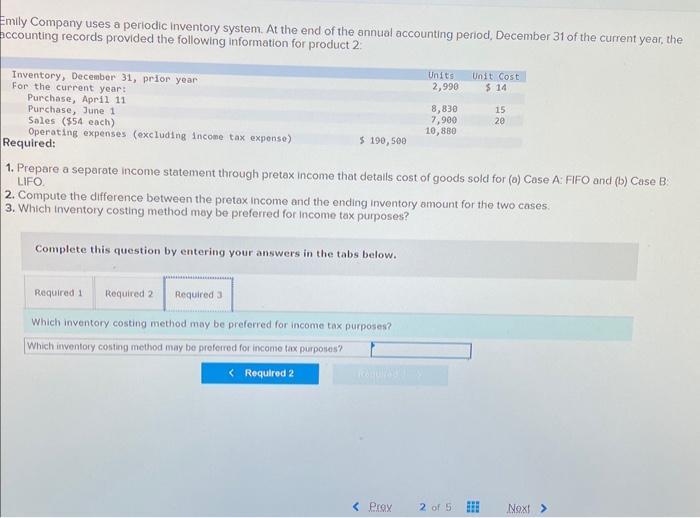Emily Company uses a periodic inventory system. At the end of the annual accounting perlod, December 31 of the current year, the accounting records provided the following information for product 2 . 1. Prepare a separate income statement through pretax income that detalls cost of goods sold for (o) Case A::FIFO and (b) Case B LIFO. 2. Compute the difference between the pretax income and the ending irventory amount for the two cases. 3. Which inventory costing method may be preferred for income tax purposes? Complete this question by entering your answers in the tabs below. Prepare a separate income statement through pretax income that details cost of goods sold for (a) Case A: FtFo and (b) Case B: LIFO: Emily Company uses a periodic inventory system. At the end of the annual accounting period, December 31 of the current year, the accounting records provided the following information for product 2 . 1. Prepare a separate income statement through pretax income that detalls cost of goods sold for (a) Case A. FIFO and (b) Case B. LIFO. 2. Compute the difference between the pretax income and the ending inventory amount for the two cases. 3. Which inventory costing method may be preferred for income tax purposes? Complete this question by entering your answers in the tabs below. Compute the difference between the pretax income and the ending inventory amount for the two cases. Note: Loss amounts should be indicated with a minus sign. mily Company uses a periodic inventory system. At the end of the annual accounting period, December 31 of the current year, the ccounting records provided the following information for product 2 . 1. Prepare a separate income statement through pretax income that details cost of goods sold for (o) Case A: FIFO and (b) Case B: LIFO. 2. Compute the difference between the pretax income and the ending inventory amount for the two cases. 3. Which inventory costing method moy be preferred for income tax purposes? Complete this question by entering your answers in the tabs below. Which inventory costing method may be preferred for income tax purposes? Which inventory costing method may be preferred for income tax purposes









